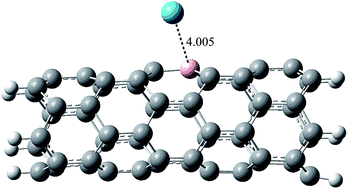Theoretical investigation of rare gas adsorption on and inside B-doped carbon nanotubes by DFT, QTAIM and NBO†
Abstract
The structures and intramolecular interactions of complexes formed by 1–2 boron atom doped single-wall carbon nanotubes (BCNTs: B1CNT and B2CNT) and rare gases (Rg: He, Ne, Ar and Kr) were studied for investigating the ability of BCNTs to absorb and sense Rg, using density functional theory, the quantum theory of atom in molecule (QTAIM) and natural bond orbital methods. One (two) Rg was placed on the surface of B1CNT (B2CNT) forming B1Rg (B2Rg) complexes, or located into B1CNT forming B1Rg-In complexes. The negative adsorption energies (Eads) of B1Rg and B2Rg show that adsorption of Rg on the surface of BCNTs is energetically favoured and based on physisorption; the very positive Ead of B1Rg-In means that the adsorption of Rg on the inside is energetically unfavoured and weak. QTAIM analysis reveals that noncovalent (covalent) bonding interactions exist between Rg and the outside (inside) BCNTs. Rg with a positive charge (QRg) is an electron donor in complexes. The electron densities of the bond critical point between attractive atom pairs, QRg, the absolute values of Ead and the total second perturbation energies (E2,tot) generally follow the order of Ar < He < Kr < Ne. The adsorption of Ne on the surface is the strongest. Changes in the electronic properties caused by Rg are useful for designing new sensors for Rg.


 Please wait while we load your content...
Please wait while we load your content...